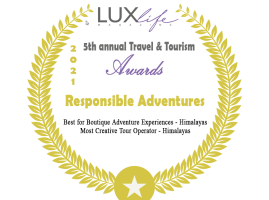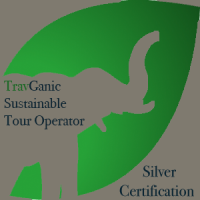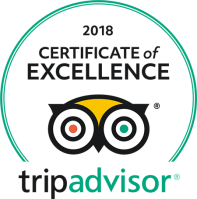Manaslu Circuit Trek First Time Trekkers Experience In Nepal
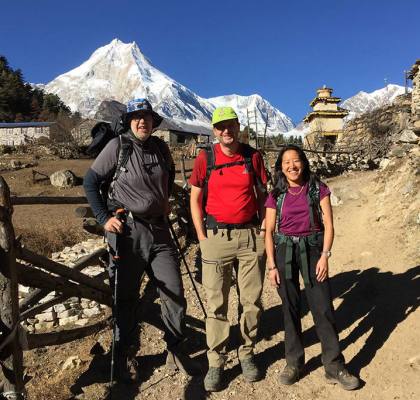
Manaslu Circuit Trek A First Time Trekkers Experience In Nepal ‘Will it be wintertime in Nepal and the Himalayas during December? How many days will you be trekking? Have you been there before?’ asked my work colleagues. ‘Er, yes, 12 days of actual walking, and no,’ I replied, knowing my Noosa workmates would be experiencing daytime temperatures of 25-32oC (77-90oF) while I would be experiencing 0- 15oC (32-59oF). Maybe lower. Definitely lower at night. Pretty cold for someone like me, born in the subtropics of Australia. I was 44 years old. I’d become reasonably fit over the past few years, but I’d never considered myself “sporty or athletic” at school. This would be the second trek of my life. The first trek elsewhere had only been four days long. I emailed Responsible Adventures often while preparing for the trip. Raj always replied promptly and supplied a list of clothes and equipment to bring. An excellent all-season sleeping bag for sub-zero temperatures was essential. “You can hire a sleeping bag in Kathmandu but not trekking poles. You can buy them here. I know from experience that cheap ones can last from a few hours to a whole trek. A good pair is an investment if you trek regularly… Bring a repair kit too.” Raj’s words became golden along the Manaslu Circuit. I remained comfortably warm inside my Kathmandu-hired sleeping bag during sub-zero nights. And because I had a repair kit, I could super-glue one trekking pole together again after over-zealously using it as a thorn-clearing scythe. As I walked with my 8kg daypack from 800 to 5135 meters above sea level and down again, I realized that the walking track exists so that food, goods, and people could move between the villages along the way. We, trekkers, were recent additions. Raj and his team carried my other 12kg of gear, organized trail visas, procured evening accommodation, regularly checked on my travel mates and health, and ensured a supply of safe water and nutritious food. They included super-food ingredients such as goji berries for energy, altitude acclimatization, and anti-inflammatory effects. And every morning, we got a lovely warm ayurvedic tea to start the day. In a relaxed, informative, and sometimes humorous way, the Responsible Adventures team informed us about Kathmandu’s colourful road traffic, how to pass mule trains (these are the “Mack goods-hauling trucks” of the Manaslu circuit walking track) and how to give goats (surprisingly easy, even when there are hundreds). In addition, I learned the names of trees, animals, and mountains, how to estimate altitude by the tree line, and discussed the pros and cons of Nepal’s planned upgrade of some walking track sections to vehicle-class roads. When we encountered the unexpected, like heat waves, landslips, or freezing gale-force winds, Raj and his team always got us through. I could focus on walking and enjoy the adventure while Responsible Adventures took care of the rest. I highly recommend them to anyone looking to do guided treks or tours. They operate in Nepal, Tibet, India, and Bhutan. By Chris Dowding – structural engineer, amateur trekker, and author of ‘A Few Drops Short of a Pint.’ He did the Manaslu Circuit Trek. Check out our Trekking packages for Nepal, Bhutan, India, and Tibet.
List of Luxury Hotels in Nepal
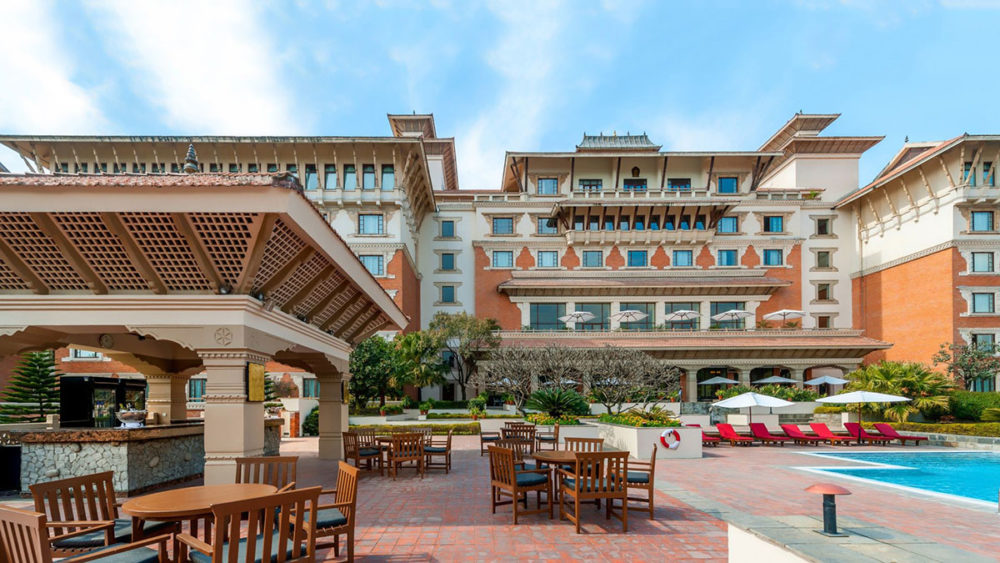
List of Luxury Hotels in Nepal Luxury hotels in Nepal are mainly available in larger cities like Kathmandu, Pokhara, Chitwan, Lumbini, and Nepalgunj. While on the other hand, smaller villages and destinations offer cosy and comfortable lodges. Whether you go on a long and strenuous path to Everest or the more gentle tracks around this Himalayan nation, it is necessary to have a comfortable place to rest. Nepal’s hotels are spread around some of the most spectacular locations, and most benefit from captivating mountain views. Many have adapted local character using materials locally available such as terracotta, red brick, and thatched roofs. Some high-grade accommodation includes luxury jungle lodges, traditional converted mansions, and beautiful rural retreats. All of them offer organic food and spa treatments. We also provide luxurious lodges in the Annapurna and Everest regions. You will get the best experience on an organised trek (unlike turning up on your own). The excellent selection of luxury lodges in the Everest region’s lower reaches allows you a two-week-long trek to Ama Dablam Basecamp and surrounding villages. These lodges prioritise trekking companies, but independent trekkers can also stay in these hotels. There are comfortable hotels in Kathmandu and restaurants serving delicious meals, while the lakeside in Pokhara is also home to some luxurious accommodation. All accommodation has been hand-selected carefully by Responsible Adventures to ensure that all accommodations are well-located and include a high degree of hospitality. For a comfortable and memorable stay in Nepal, Responsible Adventures can make hotel reservations in any category of hotels ranging between 3-star and five-stars in Kathmandu, Pokhara, Chitwan, Nagarkot, Dhulikhel, Lumbini, Bandipur at very competitive prices. Browse our portfolio of hand-picked hotels, lodges, and resorts in Nepal, listed below in the order of the popular locations: RADISSON HOTEL – KATHMANDU It is situated in the city’s heart; this hotel is finely located for local sightseeing within Kathmandu and the valley. The hotel can be reached within a ten-minute distance from Thamel and Durbar Marg’s favourite city. It has 163 well-appointed modern rooms. Each room includes superior and club rooms as well as deluxe suites. The hotel offers facilities such as the Splash Bar and Grill, an excellent rooftop restaurant, and a swimming pool with views over Swayambunath and the nearby mountains. Guests can enjoy stunning sunsets and a range of cocktails, and nightly roosts. DWARIKAS HOTEL – KATHMANDU The Dwarika’s Hote was the conception of a man’s dream to preserve Kathmandu’s architectural heritage. It is a unique hotel to stay in with lots of character. It can be considered a living museum. The 87 comfortable rooms and suites have an individual style and have won numerous awards and accolades. Custom-made furniture decorates the 74 spacious rooms and is situated around the serene courtyard at the hotel’s heart. They are in-house restaurants that offer some of the best food in town. This family-run 5-star hotel is a saviour of Newari architecture and craft that dates back to the ancient Malla dynasty from 1201 to 1769. Kathmandu valley is tearing down old buildings in its rush to modernise. Buddhist symbols on hand-printed curtains and bedspreads are used with traditional fabrics and accessories. The hotel is located within walking distance of the sacred Pashupatinath Temple and about a 20-minute drive from the city centre. HOTEL YAK & YETI – KATHMANDU This 5-star Hotel Yak & Yeti is located in Durbar Marg, a 10-minute walk from Thamel and a 15-minute drive from the centre of town and Tribhuvan International Airport. All the rooms are equipped with central air conditioning, attached bathrooms, satellite television, tea & coffee making facilities, and a minibar. It is decorated in beautiful colour palettes. Some of the rooms have a personal safe and bathrobes. The historical fountains and lush gardens surround the hotel. It also has a casino, tour desk, health club, and tennis courts. They provide accessible parking. The hotel also offers laundry and dry cleaning services. The casual Sunrise cafe overlooks the garden and pools. The Chimney Restaurant and pub’s pleasant environment provides a lovely ambience for a good meal and drinks. They also offer Halal meals. The Hyatt Regency – Kathmandu The Hyatt Regency is located in Kathmandu at a 10km distance from the city centre, on the road to Boudhanath Stupa, the holiest Tibetan Buddhist shrines outside Tibet. This hotel is considered the best in Kathmandu regarding accommodation and facilities. It has 284 rooms and six suites. The hotel is built on 37 acres of gardens. Soaltee Crown Holiday Inn Plaza– Kathmandu The Soaltee Holiday Inn Crown Plaza is situated in the suburb of Tahachal. The hotel has a total of 283 pleasantly decorated rooms. The rooms are equipped with elegant air-conditioning, cable T.V., and a minibar. The Soaltee boasts five world-class restaurants that offer continental, French, Oriental, Italian, & Indian cuisine. In addition, the hotel offers a wide selection of facilities, including a swimming pool, health club, an eight-lane bowling alley, and is home to Nepal’s oldest and largest casino. The Pavilions Himalayas The Pavilions Himalayas is nestled in the natural paradise of a lushly forested valley set against the impressive Himalayan mountain range’s backdrop. The Pavilions Himalayas is the first genuinely eco-sensitive luxury boutique resort in Nepal. They proudly grow their vegetables and dairy products on their organic farm. The perfect settings and natural beauty reflect Nepal’s deep historical heritage, while their tranquil environment is excellent for undistracted meditation. Whether adventurous or contemplative, you will appreciate the resort’s deep commitment to sustaining the natural environment. They also have a particular interest in the welfare of the people of Nepal. The Tiger mountain lodge Pokhara. The Tiger Mountain Lodge Pokhara is 1,000 feet above the Pokhara Valley with a spectacular Himalayan backdrop. It provides a perfect escape to enjoy the essence of tranquillity. It is ideal for guests pre- and post-trek. It is very suitable for those who wish to take day hikes to explore local communities or bird-watching or gentle exercise, or relax in a typical Nepalese rural setting. They are
Leave No Trace Raising Environmental Awareness In The Nepal Himalaya
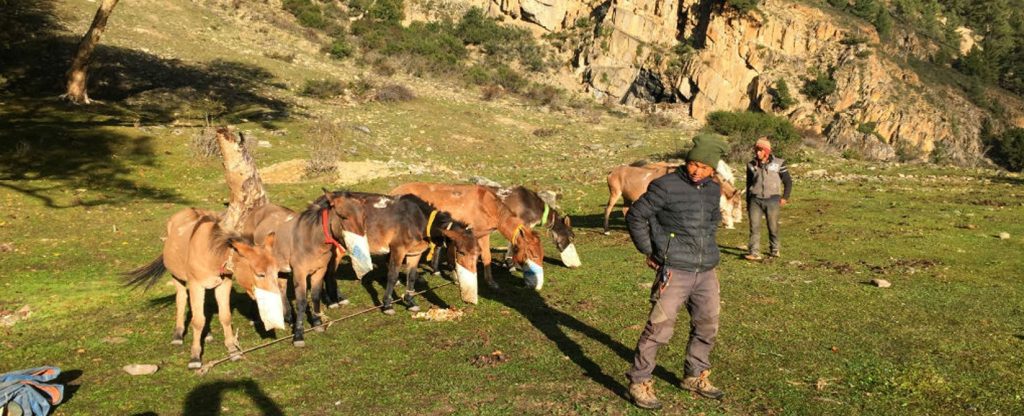
Leave No Trace Raising Environmental Awareness In The Nepal Himalayas Leave No Trace is a set of outdoor ethics that promotes outdoor conservation. There are seven principles of its practice. Planning and preparation. Travel and Camp on durable surfaces. Proper waste disposal. Leave what you find, Avoid campfires if possible; otherwise, minimize their impacts. Respect wildlife. Be considerate to other visitors. These principles have been adapted to various ecosystems, environments, and activities. Leave No Trace Center For Outdoor Ethics, a nonprofit organization known as Leave No Trace (LNT), has existed since 1994 to educate people about their impact on nature through their recreational activities and Leave No Trace principles to prevent or minimize such effects. We at Responsible Adventures have continually educated our trek leaders, support crew, and porters on how to trek in an environmentally friendly manner. Some porters have even started collecting rubbish they see in their resting places. I led a group from Poland on a remote Upper Dolpo traverse trek from Late September until the middle of October 2017. We saw that even this remote region, which has a relatively small number of trekkers compared to other Nepal trekking areas, was beginning to get some form of rubbish at the trails and campsites. “It is one of the cleanest areas I have trekked in, and it must be kept in its pristine state. “There were constructions of a growing number of lodges in anticipation of more foreign and local trekkers. With rapid development without proper education on environmental issues, the locals do more damage than benefit the locals and their sensitive surroundings. My first opportunity was to meet the newly elected Mr Tashi Tundup Gurung – Head of Shey Phoksundo Village Municipality, at his home in Saldang village. I formally introduced myself to him and sat down to have a serious talk with him after exchanging pleasantries. I asked him what his thoughts on tourism were, to which he replied that it benefits the people of inner Dolpo very little. The trekking companies hire pack animals and buy most rations for this camping trek in the lower regions, despite fresh vegetables and rations being available in Dolpo’s interior villages. I told him how beautiful his District was and how important it was to educate the new entrepreneurs and the staff of camping groups about keeping the surroundings clean. Mr Tashi mumbled, why bother when they receive no benefit? I told him this was why they should insist all camping groups bring out the rubbish they produce; the villagers should tell the trekking group’s staff that they are welcome to visit their beautiful District and understand their culture and religion but leave their environment pristine. To encourage him further, I said that the Dolpa district could lead the country on Leave No Trace principles by cooperating with neighbouring Village Municipality chiefs to implement these policies. Despite being new on the trekking scene and being a very remote district, they can be ecologically sound. This got Mr Tashi excited, and it was evident on his face. He thanked us for visiting and educating him on environmental issues and sounding my concerns for their District. Awareness needs to start at the grassroots level to implement LNT policies; I spoke to our mule drivers, Kaji and Bhim. They were reluctant in the beginning. However, they were convinced that trekkers could go to many other areas or countries should their District become dirty. This is part of our ongoing Responsible Tourism Practices. Check out our Trekking packages for Nepal, Bhutan, India, and Tibet.
How to trek safely in Nepalese mountains
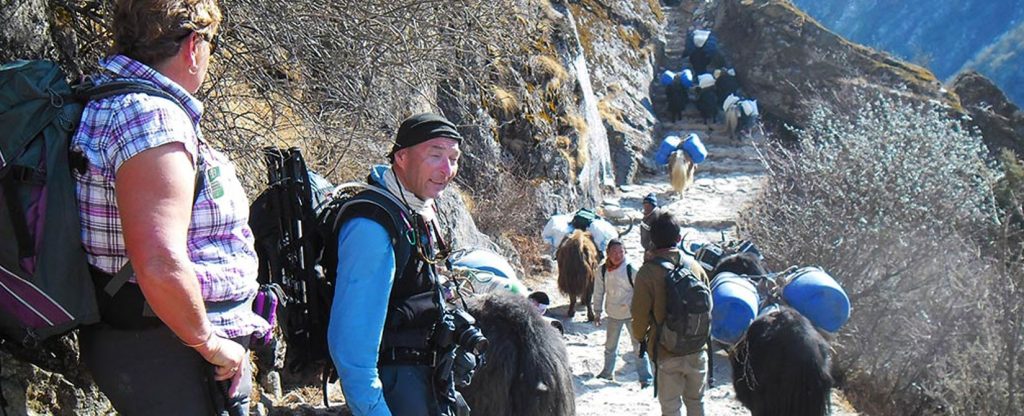
Learn how to trek safely in the Nepalese mountains Updated 13/12/2023. Here is some advice on remaining safe while trekking/hiking on the trails. Always walk on the wall side of the trail. You may encounter caravans of pack animals or porters carrying large loads. You wouldn’t want to be pushed off accidentally. Don’t listen to music using earphones, as this will prevent you from hearing oncoming caravans of pack animals. When you come across wet stones or rocks with algae on a damp trail, assume it is slippery and possibly dangerous. You will come across fascinating sceneries, villages, people and wildlife. Stop to admire, observe, or photograph them. Plenty of stones and rocks are on the path; you don’t want to trip on them and injure yourself. Use Sunblock of factor 30 or more. Have a sun hat, warm hat, waterproof and 2 litres or more water to drink. Camelback is the best equipment to carry water as it provides easy access to water while trekking. Walk at your own pace. Listen to your breathing. If you are huffing and puffing while trekking, you are going too fast for your lungs. At altitude, you are seriously advised to take it slowly and steadily. If possible, do not ascent more than 300 meters in a day. Have an acclimatization day every 1000 meters. Ascending too fast can lead to Acute Mountain Sickness. Sudden movements can cause you to be breathless or dizzy at a high altitude. Drink plenty of nonalcoholic fluids such as water, juice, hot chocolate, soup, etc. Try to minimize the intake of coffee and tea, as both are diuretics, which cause you to pee more. Do not take medicine with suppressants such as codeine or similar ingredients. Now and again, trekkers go missing in the mountains. You would not want to be another statistic, would you? DO NOT travel solo in the wilderness. Always inform your embassy or family and friends when you need to go alone and give them your travel route. Inform them of your whereabouts via phone, text, email, or social media when you can access the internet or whenever possible. When you walk through landslide areas, look above for passing animals, which can cause rock falls. These precautions can be utilized for trekking safely in Tibet, Bhutan, Ladakh, Sikkim, and Darjeeling in India. Do not pet or feed animals. No matter how cute dogs, cows, buffaloes, or other animals look, DO NOT pet them. One can never tell how the animal feels; you might get bitten. If you are trekking during the summer in Ladakh’s rain shadow areas, Upper Mustang, Upper Dolpo, Humla, or Tibet, be careful when you come across sheep or yak herders’ campsites. They have big Tibetan Mastiffs that can be aggressive as they protect their herds and flocks in the high summer pastures. Be careful in early autumn when you approach high-altitude villages of these mastiffs, as they can still be protective when they have just arrived from the summer grazing pastures; they can give you some nasty bites.
Tourism in Ladakh
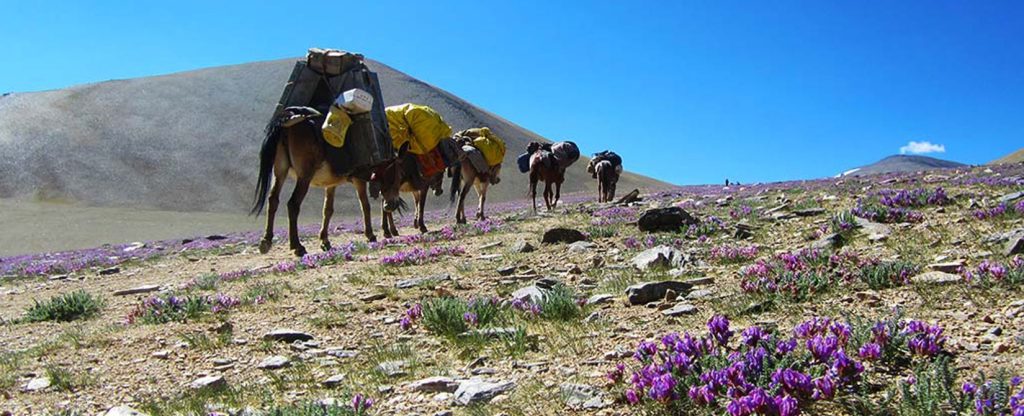
Tourism in Ladakh Ladakh (“land of high passes”) or La Dwags in Ladakhi is a region in the Indian state of Jammu and Kashmir. It extends from the Kunlun mountain range to the central Greater Himalayas to the south. People of Tibeto Burman and Indo-Aryan descent inhabit the region. It is a sparsely populated region of Jammu and Kashmir. Its culture and history are closely related to those of Tibet. Ladakh ruled over a vast expanse during its heyday. In addition to the currently existing areas, Baltistan valleys, mainly in Pakistan now, much of Ngari, including the Guge Kingdom in the east and Aksai Chin in the northeast, used to be part of Ladakh. Contemporary Ladakh borders Tibet to the east, the Lahaul and Spiti region of Himachal Pradesh state in the south, the Vale of Kashmir regions to the west, and the southwest corner of Xinjiang in the far north. Ladakh is renowned for its remote mountain beauty and culture. Ladakh’s strategic location at the crossroads of important trade routes gained importance in the past. Still, since the Chinese authorities closed the borders with Tibet and Central Asia in the 1960s, international trade has dwindled except for tourism. The government of India has successfully encouraged tourism in Ladakh since 1974. In addition, Ladakh is of strategic importance to Jammu and Kashmir, and there is a strong presence of the Indian military. The most substantial town in Ladakh is Leh, followed by Kargil. Nearly half of the Ladakhis are Shia Muslims, followed by Tibetan Buddhists and a small Christian population. Interests include Leh, Suru valley, Zanskar, Padum, Phukthal, and Shayok Valley, among the favourite tourist places. Must-Visit Places The Leh Palace, situated behind the main bazaar, is eight stories high and was designed to look similar to the Potala Palace in Lhasa. Just ahead of the palace is the famous Chamba Temple, a single-roomed shrine with a large icon of Maitreya, the future Buddha. At the top of the street, one can see the Jama Masjid. The Mosque is painted green and white. Another must-visit place is the Sankar Gompa, situated within the city and is one of the oldest structures. Places To Stay There are extensive selections of low-cost, mid-range accommodation offering decent value. However, in recent years, few boutique hotels have sprung up, offering different experiences. A visit to the famous Thikse Monastery is a must. This monastery is the most substantial structure in central Ladakh and is primarily known for Maitreya’s giant statue (future Buddha). Ladakh offers terrific trekking destinations, having some of the most picturesque and challenging treks in the entire Himalayan region. Ladakh is a paradise for adventure lovers due to the mightiest mountain ranges, the Greater Himalaya and the Karakoram, the Ladakh range, and the Zanskar range. Trekking in Ladakh presents you with picturesque mountains and breathtaking landscapes. Popular treks The treks from Jingchen to the Markha Valley The Rumtse to Tsomoriri trek The Zanskar Trek The Lamayuru to Alchi trek The Sham trek also is known as Likir to Temisgam trek. Best Time to Trek Treks are possible from the end of June until mid-October. Some of the passes along the treks are higher than 5,000 meters in altitude. Many trekking agencies in Leh offer trekking packages with a guide, packhorses, food, and supplies. Good roads to all significant places in India connect Leh. Leh is 1047 km from Delhi, 434 km from Srinagar, 230 km from Kargil, and 494 km from Manali. The overland approach to Ladakh from Kashmir Valley via Kargil is approximately 434 km; it remains open for traffic from early June to November. The exciting part of this road journey is the ascent up the 11,500 feet 3,505 m high Zoji-La, which serves as the gateway to Ladakh. There is also a road between Manali and Leh, which is 473 km long. Manali to Leh Road has served as the second overland approach to Ladakh. Open for traffic from mid-June to early October, this high road traverses the upland desert plateau of Rupshu, where the altitude ranges from 3,660m to 4,570m. A total of 5 high passes fall en route, among which the highest is Taglang-La, which our Indian friends claim as the world’s second-highest pass at an altitude of 17,469 feet/5,235 m, and the Khardungla is the highest road in the world. For facts claiming otherwise, click here. The Himachal Pradesh Tourism (HRTC) and J&K State Tourism (SRTC) operate daily Deluxe and Ordinary bus services between Manali-Leh and Srinagar-Leh. The bus journey between Leh and Manali takes about 19 hours or two days, with an overnight halt in Sarchu or Pang camps. And the Srinagar-Leh trip takes 17 hours. Air also connects Leh from Delhi, Srinagar, and Jammu. We wish you a wonderful holiday in this highland. If you need any assistance in putting together a memorable trip, please get in touch with us. Check out our Trekking packages for Nepal, Bhutan, India, and Tibet.
Ladakh Is One Of The Few Regions For A Summer Himalayan Trek in India
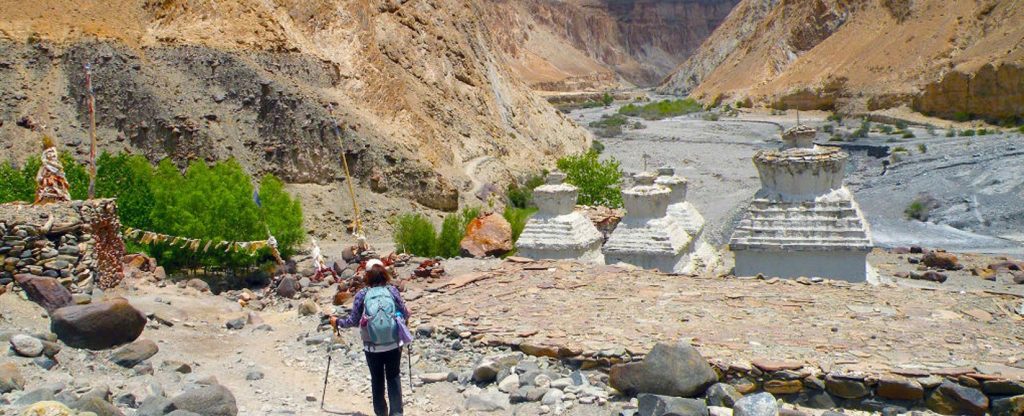
Ladakh Is One Of The Few Regions For A Summer Himalayan Trek in India Leh, the capital of Ladakh in Northern India, is only an hour’s flight away from Delhi. However, for the more adventurous and those who don’t suffer from motion sickness, you can opt for a bone-jarring 22-hour plus bus ride. The stunning scenery on this drive has to be done once in life! Ladakh means land of high mountain passes. The Buddhist monasteries, spectacular pastel-coloured deserts, jagged peaks, and colourful prayer flags flapping in the wind are Ladakh’s characteristics. Although stark, Ladakh’s landscape is magically colourful. The summer is green in the valleys, with snowmelt streams feeding the green pastures and crop fields. Brilliant colours of the prayer flags flutter on the roofs of traditional whitewashed houses. The bright sun shines intensely throughout the year in Ladakh, making it sensible to use solar Para boilers to boil water or cook. It shares its borders with China and Pakistan. India has had wars with both, which makes Ladakh a militarily strategic area. It was opened for overland travel in 1974 when the tensions lessened with China. The local population and military presence stand about in equal numbers – 250,000 each. Once a Kingdom and an essential part of the Silk Route, Ladakh is now part of Jammu and Kashmir. The Ladakhis are an exciting mixture of Tibetan, Central Asian, and Indo-Aryan. It became part of Independent India in 1948. Ladakh is one of the few areas in the Himalayas that sits in the rain shadow where the mighty mountains block the Indian sub-continent’s monsoon clouds from passing through. Ladakh is fast becoming a playground for the fans of the Himalayan Adventure holidays during the summer season. They do get “freak rainfalls” every few years. In 2010, she witnessed a catastrophic flash flood in which nearly 200 people were killed in Leh. You can walk on ancient paths through Buddhist villages with Tibetan architecture, which brings you back in time. On the way to Leh Palace, you will encounter numerous Tibetan refugees selling prayer flags, turquoise, and coral jewellery alongside the Kashmiri merchants who offer pashminas and beautiful silk carpets. The Leh Palace was a crumbling ruin until it was refurbished recently. With its sloping, buttressed walls and overhanging wooden balconies, the re-renovated Palaces stand majestically over Leh’s city. Carved lion heads guard the palace entrance, and the throne room is painted with tigers and Buddhist murals, maintaining its ancient grandeur. Smiling locals will greet you with “Jullay” while strolling in the market/bazaar area. “Jullay” is Ladakh’s traditional greeting, which is used at all times of the day. It can mean – “Hello,” “Thank you,” and “Goodbye.” Most visitors to Leh visit Hemis Monastery, which is an hour’s drive south of Leh. Hemis is one of Ladakh’s most important monasteries, and on the ride back to Leh, most tourists stop to visit the Thiksey monastery. The Thiksey monastery sits on top of a hill with its whitewashed temples with magnificent paintings. One can walk from temple to temple with the scent of burning incense and butter lamps, and if you are there early in the morning or the evening, you might even hear the monks chanting. The main attraction of the Thiksey monastery is the two-story-high Maitreya Buddha statue. Another popular acclimatization tour is the walkthrough fields lined with poplars and willow trees to the fortress and monastery at Shey, once the king’s summer palace. The popularity of Ladakh’s natural beauty has increased the number of visitors from the West as a choice for summer trekking vacations. As a result, there is a growing number of hotels and guest houses in Leh. Ladakh’s popularity has grown tremendously with domestic tourists after a movie with Ladakh scenery became a super hit. Previously the tourist season used to be in July and August. However, India’s new economic boom has become an all-year destination. Some treks we offer in Ladakh The treks from Jingchen to the Markha Valley The Rumtse to Tsomoriri trek The Zanskar Trek The Lamayuru to Alchi trek The Sham trek also is known as Likir to Temisgam trek. Check out our Trekking packages for Nepal, Bhutan, India, and Tibet.
How to Find Your Purpose and Passion for shifting Your Life
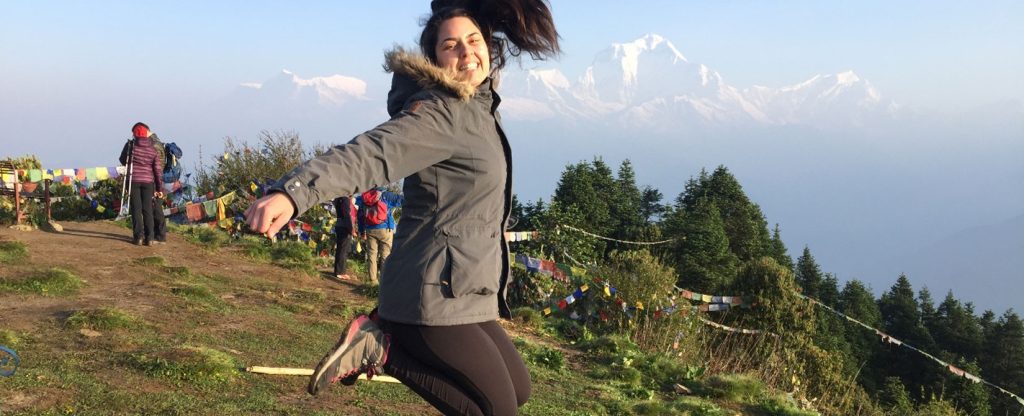
How to Find Your Purpose and Passion for shifting Your Life Spirituality / By Tracy Latz, M.D. & Marion Ross, PhD How to Find Your Passion and Purpose Wouldn’t you love to jump out of bed every morning filled with fire and enthusiasm for something? Perhaps you have been searching for that something for years or have settled for a more mundane life out of not knowing any better way. Maybe you feel that you have too many responsibilities to change course, do not deserve anything more significant, or have a fear of the unknown. Finding & Following your passion and purpose can be difficult, but consider it a journey, not an instant revelation. Go back in time… Consider taking an expedition into your past, for starters. What life plan got you to where you are now? Did you even consciously have a plan? Were you driven by the desire to be a dad, mom, nurse, doctor, plumber, an Indian chief, or accountant because it was lucrative or ‘Cool,’ to impress your family or friends, perhaps to pay the bills, or was it something you wanted to do? Did you choose a life of hiding your talents and brains so people would not expect too much of you? Were you afraid of success, or did you have a fear of success or failure? What choices led you to your current job, personal /family situation, hobbies, what you do in your downtime, etcetera? Take time to evaluate how you got where you are now to understand how you have been creating your life. Remember what Einstein said: “We cannot solve problems using the same thinking we used when we created them.” To discover your passion, you must expand, stay what you think, recognize what you wish to eliminate or change in your life and be motivated to do it. Your current thought process might have limited your options to provide you with a certain level of security, comfort, and survival, and maybe has given you a comfortable enough box to nest in, which you call “my life.” “Choose a job you love, and you will never have to work a day in your life.” – Confucius. To discover your real purpose in life, you must first rid your mind of all the parental and societal expectations that have filled your awareness since childhood. Then, sort out what is significant for you. To find your passion and purpose, recognize your gifts and abilities. Teaching, coaching, selling, painting, listening? Figure out what you are good at and what you enjoy doing. Define your interests! What makes your heart sing? What have been your hobbies since childhood? Do they give you a hint as to what lights your fire? What have you been afraid to pursue because of money or other barriers you have always wanted to do? What do you love to research on the internet? What section of the book store do you hang out in & which magazines do you enjoy reading? What inspires you? Please bring all of this to mind, write it down, and then refine the list after reviewing it in a few days. What have you fantasized about doing that seemed too crazy to pursue? Did you ever have a dream that you never realized, such as being a writer, journalist, or painter, which internal self-doubt or fear prevented you from pursuing? Take another look at your life dreams! It is never too late to create yourself anew. However, if you have an inhibiting belief that limits you from moving forward in your life, we have tools to help you remove the obstacles that cause a sense of being ‘stuck.’ Are you ready to find your passion and purpose and create a positive transformation in your life? Explore the roots of your self-sabotaging beliefs and behaviours at Shift Your Life: Drop Your Baggage. Love Your Life and Reach Beyond the Veil With Intuitive Art at the Art of Living Retreat Center from June 22nd-26th. Tracy Latz, M.D., M.S., is an Integrative Psychiatrist weaving together wisdom from Western medicine and alternative approaches to transforming anxiety, depression, and emotional trauma. Marion Ross, PhD, holds doctorates in Holistic Healing, Metaphysics, and Transpersonal Psychology and certifications in Medical Qigong, Qigong Healing, Robert Peng Certified Teacher Training, Energy Medicine, Mind-Body Medicine, and Sound Healing. This article was first posted on shiftyourlife.com, and Art of Living Retreat Center’s Website is republished with the authors’ permission. Check out our Trekking packages for Nepal, Bhutan, India, and Tibet.
Holi or Fagu Purnima the festival of colors in Nepal

Holi or Fagu Purnima, the festival of colours in Nepal When does Holi take place? 29th and 30th March 2021 8th and 9th March 2020 20th and 21st March 2019 Holi or Fagu Purnima’s date changes according to the Hindu calendar. The Hindu calendar is based on solar and lunisolar calendars. It is very different from the Gregorian calendar, so most important festivals occur on other dates or even months on the Gregorian calendar. In Nepal, we have a unique practice where the hillmen celebrate a day ahead of the Terai residents. Like many of the festivals of this region, there are many myths and stories behind each festival. Holi is welcoming spring and summer. It is also observed to get a blessing from God for coming harvests and fertility of the land. This festival is celebrated in most South Asian counties. Holi takes place on the night of Falgun Krishna Chaturdasi. However, the celebration starts on the next day of the Fullmoon (Purnima). Holi is a festival of colour, camaraderie, and love. How Holi is celebrated Holi in Nepal starts a week before the primary day of the festival. The tradition is to erect a long bamboo pole covered with different coloured cloths (called Chir locally) in Basantapur, Durbar Square. On the eve of Holi, the bamboo pole (lingo) is brought down, and the bamboo pole (Chir) is burnt. This occasion is known as Holika Dahan or Chir Haran, after which the festival of Holi begins. This festival is celebrated with colours, music, sweets and most of all with water. The participants put colours on one another, a token of love. People go from house to house with relatives and friends in groups during the celebration. Putting coloured powder or liquid form while eating traditional Indian sweets throughout the day is how they celebrate Holi. Some people also play music and dance during this festival. The people of the hills in Nepal celebrate this festival a day ahead of the Terai region and India. Therefore the festival of Holi is celebrated for two consecutive days by the different areas of the nation. Some participants use water guns to squirt water on others during the celebrations. Traditionally it used to be made of bamboo, but these days modern plastic water guns are used. In addition, the popularity of balloons and plastic bags filled with water is a less expensive way to have fun for the youth. Children start throwing water-filled plastic bags and balloons as early as a week before Holi begins. People gather firewood to light fires while playing music and dancing. Some indulge in bhang (an edible cannabis preparation) with mixed lassis to enhance their celebration. The alleys of villages and towns are alight with firewood. This is considered an essential part of the Holi festival. It symbolizes the end of Holi (Holika Dahan). Government offices are closed on Falgun Purnima in Nepal’s hilly regions as Holi is an official holiday here, while the Terai region celebrates Holi the next day. Tales behind Holi There are numerous stories behind the Holi festival. Lord Krishna and Radha It is said that Lord Krishna was continuously moaning to his mother, Yasodha and that all his girlfriends teased him by calling him the dark one (Kala). He is believed to have asked Yasodha why he was dark when all his girlfriends (Gopinis, including his beloved Radha) were fair. Yasodha, in turn, gave Krishna various colours and asked him to throw them on all the Gopinis’ faces so they, too, would look dark like him. Krishna brought the colours and applied them to all the Gopinis. The Gopinis loved the colours as they were all head over heels in love with Krishna and enjoyed the occasion. This is one of the tales of how Holi began. Death of Holika It is also believed that Holi is the day Holika died. It is to celebrate her death. Praladh was the son of Hiranyakasyapu, a demon. Hiranyakasyapu thought of himself as the most powerful being in the Universe and wanted everyone only to worship him. Praladh, on the other hand, was a devotee of Lord Vishnu. Hiranyakashyapu tried to convince his son numerous times to worship him but failed miserably. So Praladh continued to worship Lord Vishnu. Hiranyakasyapu plotted the murder of a 5-year-old son. He ordered Holika, his sister, to kill Praladh. Holika was gifted with a fireproof dress. It is believed that she carried Praladh into a flame. However, due to his faithful devotion to Lord Vishnu, Lord Krishna came to his rescue and burnt Holika instead. Holika Dahan, which means the end of Holika, is now known as Holi. People celebrate the death of Holika with colours to this day. The people make a replica of Holika out of hay and burn it at the festival of Holi. Krishna and Draupati It is also said that Holi is celebrated to honour Krishna’s protection of Draupati’s modesty by producing several lengths of cloth when the Kauravas stripped (Cheer Haran) her while her husband, the Pandavas, hung their head in shame. So it is another tale linked to the celebration of Holi. Dhundi and boys Another tale has it that once upon a time, in the Kingdom of Prithu, a horrible ogress called Dhundhi began to trouble the children. She had received a boon from Lord Shiva, protected from getting harmed by Gods, men, weapons, heat, cold, snow, or rain, making her more or less indestructible. However, Shiva had also given her a curse whereby boys could be dangerous to her. King Raghu arranged for some boys to seek the ogress with wood in their hands through his priest’s advice. They were further empowered with mantras to go around Dhundi thrice while chanting them, making loud noises to annoy the ogress. On the first day of spring, the group of boys collected firewood, lit it alight, and started dancing, and the consumption of bhang intoxicated them. Then, under the influence of
Helambu Family Trek during The Monsoon
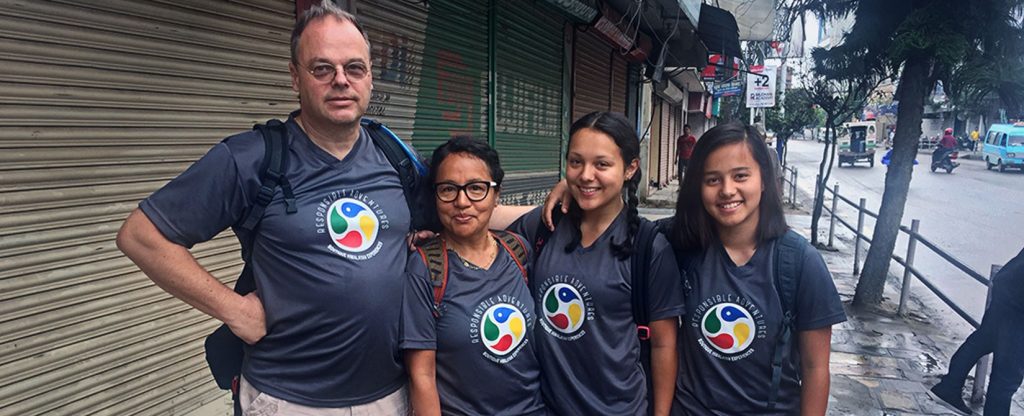
Helambu Family Trek during The Monsoon Day 1: A mutual friend introduced The Thuene Family. After exchanging numerous emails discussing whether to take on the Annapurna Circuit clockwise, the opposite of 99.9% of the people does. It would have involved going over the Thorung La pass 5416 early on the trek. The Thuenes suggested a supposedly easier and shorter trek in the Helambu region instead. We finally started the trek on the 9th of July. We picked up the family at an agreed pick-up point and drove for an hour to Sundarijal – the trek’s starting point. We met the rest of the team and were on our tour when the porters finished tying up the kit bags. We walked along a ridge through a forest of Oaks and Rhododendrons towards Chisopani. Being out of the hustle, bustle, and Kathmandu’s dusty roads was a relief. Just an hour’s drive away, we were in another world altogether. We enjoyed the tranquillity, remoteness, and green mountains. We stopped at Mulkhara at 1855 meters for lunch, where we had climbed approximately 400 meters. Pemba, our Trekking chef, was about to serve our lunch when he was stung by a bee without any provocation; Kishor, our porter, pulled out the sting from Pemba’s neck. A few minutes later, the opposite side of Pemba’s face was swollen – my first thoughts were that he had swallowed something huge, and then I realized that it was a reaction to the bee sting. I looked out for the following symptoms – i) Rapid swelling around the eyes, lips, tongue, or throat. ii) Wheezing or hoarseness. I also asked if he had the following: Difficulty in breathing. Itching, cramping, or numbness that is severe. Dizziness. A reddish rash or hives. Stomach cramps. Pemba said he felt slight discomfort on the swollen face but was fine otherwise. I asked the locals if they had seen anything like this before, to which they said they react the same way when stung by these bees. They told us the local remedy was to rub locally made hooch or a fermented drink called Chang, and the swelling would go away in 1-2 days. It was a relief to hear that. We continued our trek upwards towards our destination. I heard a villager smile on the trail and told his friend one more was stung by the bees when he saw Pemba. A few minutes later, I saw a guy with an eye swelling and bright red swollen lips, which said: “so your friend has been stung too.” I felt terrible for him and Pemba but was somewhat relieved to see the local calm and collected – it meant it was common for this to happen. Later, we concluded that the bees must have had some intoxicating nectar of wildflowers to make them attack humans without provocation during the monsoon. We continued climbing up to Borlang Bhanjhyang, 2430 meters, the highest point of the day, before descending to Chisopani. Unfortunately, it started to rain when we got to Borlang Bhanjyang. Fortunately, Chisopani wasn’t that far away. Unfortunately, the damaged and destroyed lodges by the April 2015 earthquake were left as it was. Upon asking the local lodge owner why this was so, he replied that the people running those lodges had illegally constructed and operated the lodges inside the Shivapuri – Nagarjun national park. We would have witnessed the majesty of Gaurishanker, Ganesh Himal, Manaslu, and Annapurna ranges on clear days. We woke up the next day on a windy morning. We started trekking downhill towards Pati Bhanjyang at 1830 meters. Then, we started climbing towards Chipling, 2170 meters, for lunch. We continued through sparse villages and forested areas. We witnessed many people living in temporary shelters after the earthquake two years ago. When we got close to Gul Bhanjyang, a village where only 2 or 3 rebuilt houses stood (it was thick with fog), it started raining around 3 pm, as it had done for the past two weeks. Our destination of Kutumsang was still 2 hours away. So we decided to stay at Gul Bhanjang for the night. The lodge was quickly built to temporarily cater to trekkers until they saved enough money to construct a bigger and better club. Pemba prepared “Himalayan Carbonara” as a consolation for dinner. Day 3: It had started raining/drizzling right from the very start of the day. It looked like the monsoon had kicked in. We had to go through the leech-infested forest; they would wait stealthily on bushes, rock steps, and dry leaves stacks. We had a particular leech “repellent” made of rock salts tied in a piece of cloth. The rain made the red clay, stones, and roots sleek, and the leeches added to the obstacle for that day. We aimed to have lunch at Magengoth 3390 meters, as there was nothing after leaving Kutumsang village. The first lodge site relieved us to learn that it had been damaged and abandoned; we had to go on for another 30 minutes till we arrived at the other lodge. I had a quick discussion with the team and decided to stay here for the night again, 2 hours before our planned stop. We were fortunate to have a very kind hostess who kept us warm with a fire in the dining hall, where we dried our wet clothes. Leeches had bitten all of us. I had three on my ankles, one on my left elbow and one on the left side of my neck. We were grateful that this lodge saved the day for all of us. Day 4: We woke up at our usual 6 am with a unique concoction of Ayurvedic and apple cider vinegar with a honey drink to keep us energetic and anti-inflammatory. 7.30 am, and we started trekking, hoping to get to our stopping point before 3 pm to beat the rain. We hiked through a beautiful green area, passing past several settled landslide areas. However, we were cautious
The health benefits of ginger
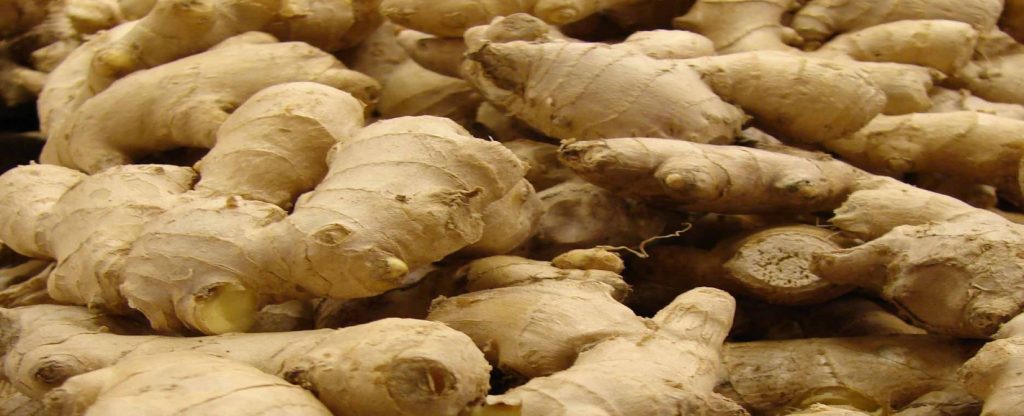
The Health Benefits of Ginger. Naturally, Wellness: The Health Benefits of Ginger The ancient plant ginger is grown all over the world. It is widely known for its culinary use and is found in various compositions. However, ginger is not just another spice that can be added to your cherished dishes. Ayurveda’s holistic healing approach knows the mind’s interrelations body and lauds ginger as a tonic that balances the body. The ginger root also provides a wide variety of health benefits. Ginger to help with weight loss Being overweight can reduce a person’s life expectancy by as much as twenty years. Nonetheless, research shows ginger may be conducive to weight control and curbing obesity by reducing various contributing elements such as glucose and body weight. Ginger for glowing skin. Thanks to its approximate 40 antioxidant properties, your skin is protected against free radical damage and protection against ageing. In addition, studies have shown that ginger helps reduce the synthesis of melanin, which reduces the skin’s ageing process. Keeps infections at bay. Ginger’s antimicrobial elements make it a potent tool for fighting infections, including bacterial infections like strep throat. In addition, it has been used as a treatment for various conditions, including flared sinuses, nausea, and flatulence. Ginger also supports the immune system during the flu and cold season. Reduce inflammation and pain. Some conditions, such as rheumatoid arthritis and fibromyalgia, can come with chronic pain because of inflammation, which is the body’s natural reaction to heal injuries. The longer the swelling continues, the more painful it can be, but ginger can provide alternative pain relief. Studies have shown that ginger reduces pain and inflammation due to the presence of essential oils and gingerols. Ginger for improved digestion. This well-known superfood can help you not only digest your food but can also provide control and enhance your appetite. Consuming ginger during lunch is a regular Ayurvedic practice; it helps facilitate the absorption of nutrients. Include ginger in your diet. Taking advantage of ginger’s health benefits is not difficult to do. Here are four easy ways how you can add ginger to your diet. 1. Ginger tea. This drink relieves stress and boosts your mood. In addition, ginger tea can provide calming relief when you have a cold. You can slice the ginger root thinly and boil it in water to get a substantial taste from the warm beverage. Ginger powder can be added to your hot drink, or a more natural way is to steep ginger tea bags in hot water. 2. Use ginger as a spice in your cooking. Ginger adds a little ‘bang’ to flavouring fruits, vegetables, and meat. Try boosting the taste of your vegetables, chicken, or even steak by adding some freshly peeled ginger to your dish. 3. Pickled Ginger. A pickled form of ginger can be added to your diet. The ginger pickle is an exceptional appetizer. It helps to neutralize your taste buds, especially after food with strong after tastes, such as raw fish or sushi. The health benefits of ginger stretch beyond its culinary appeal; it controls appetite, healing, and rejuvenation. You can adopt the Ayurvedic approach to broaden the balance from the mind to the body and leverage its numerous benefits by using ginger’s power. This article originally appeared on Art of Living Retreat Center Check out our Trekking packages for Nepal, Bhutan, India, and Tibet.










